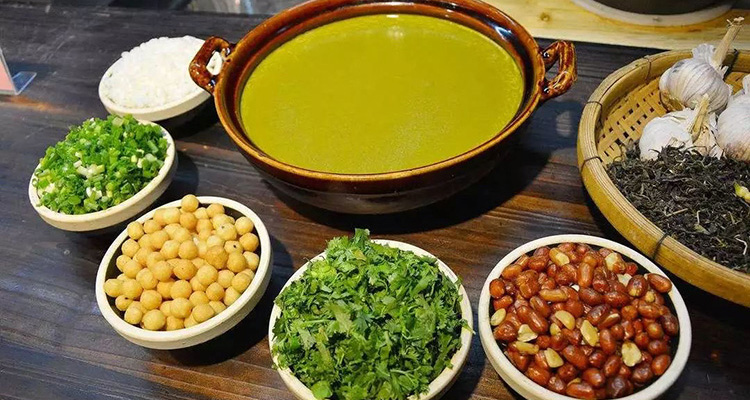Warm North China Oil Tea: Traditional Youcha Guide
Lead: In the biting northern winds of China, few things warm the body and soul like a steaming bowl of oil tea (Youcha). Not a simple mix of oil and tea, this centuries-old comfort food blends fried flour and crushed nuts into a nourishing, hot paste. From Shanxi’s homely kitchens to Shaanxi’s bold flavors and the wide plains of Inner Mongolia, oil tea creates unforgettable travel memories. Join us to explore its story, taste, and traditions.
1. Origin and History: A Millennia-Old Staple from Nomads to Homes
Oil tea (Youcha) dates back to ancient northern China. It was a vital, energy-rich food for both nomadic herders and settled farmers. Records suggest that as early as the Tang and Song dynasties, northerners mixed roasted flour with nuts to fight the cold and restore energy. Over centuries the simple mix evolved with local ingredients and seasonings into the oil tea we know today—both a practical winter food and a cultural symbol across ethnic and regional lines.
2. Cultural Meaning: A Warm Memory in Northern Homes
In northern China, oil tea is more than a snack—it’s a ritual of daily life. In Shanxi, Shaanxi, Inner Mongolia, and Henan, many households start the day with a bowl. It symbolizes warmth, reunion, and simple hospitality. During festivals or family gatherings, oil tea is often served to guests as a sign of welcome. For locals, its flavor often equals the taste of home.

3. Key Ingredients: The Golden Mix of Nuts and Fried Flour
Oil tea’s appeal comes from its rich, simple ingredients. The base is carefully pan-fried wheat flour, cooked until slightly golden and fragrant. Crushed peanuts, sesame seeds, walnuts, and sunflower kernels are added for crunch and nutrition. Salt or sugar creates the two main flavor profiles—savory or sweet. In some regions, small amounts of beef tallow or mutton fat are added for extra richness.
4. How It’s Made: Patient, Low-Heat Craftsmanship
Authentic oil tea requires attentive cooking. Flour is slowly toasted over low heat and stirred constantly until it turns light golden and emits a toasted aroma—timing is crucial to avoid bitterness. Roasted, crushed nuts are mixed in. Traditional recipes sometimes add a bit of animal fat while frying to make the texture smoother. The finished oil tea powder is stored sealed; to serve, simply whisk it with boiling water into a thick paste.

5. Flavor and Texture: Savory and Sweet Comfort
Prepared oil tea is thick and porridge-like. The first notes are the toasted flour and crunchy nuts, followed by the salt or sugar that defines the savory or sweet versions. Savory oil tea often carries a subtle five-spice undertone and deep, hearty flavors; sweet oil tea highlights the nuts’ natural sweetness and feels soothing on the throat. Both provide warming energy on cold mornings.
6. When to Eat: From Breakfast to Late-Night Snack
Oil tea is commonly enjoyed at breakfast or as a late-night snack. A hot bowl paired with fried dough sticks or a flatbread makes a satisfying morning meal. At night it comforts and warms. Because it’s portable, oil tea powder plus hot water works well for outdoor workers. It also pairs well with other local specialties—try it alongside Xi’an’s roujiamo or Shanxi’s knife-cut noodles for complementary flavors.

7. Tasting Tips: Enjoy It Like a Local
If you’re trying oil tea for the first time, start with a small bowl and choose sweet or savory based on your preference. Savory versions pair well with salty foods; sweet ones are pleasant on their own or as a light dessert. Stir thoroughly to dissolve the powder and avoid lumps. During winter mornings, seek out street stalls for the freshest, hottest bowls and a genuine local experience.
8. Where to Try the Most Authentic Oil Tea
For the most authentic oil tea experience, visit the old quarters and traditional markets in Taiyuan (Shanxi), Xi’an (Shaanxi), Hohhot (Inner Mongolia), and Zhengzhou (Henan). Long-running breakfast stalls and family-run eateries in these cities preserve time-tested recipes. If possible, join a local food tour to learn hands-on about oil tea culture.

9. Simple Home Recipe: Recreate Northern Flavor
You can make a simple home version anywhere. Slowly toast plain wheat flour in a dry skillet until golden. Mix in roasted crushed peanuts, sesame, walnut pieces, and a pinch of salt or sugar. To serve, scoop the mix into a bowl and stir with boiling water until it reaches a porridge-like consistency. Add a little milk for creaminess if desired.
Conclusion: A Warming Northern Classic
Oil tea, a traditional north China specialty, is both a taste experience and a cultural encounter. From ancient origins to everyday breakfast tables, this humble dish showcases northern resilience and hospitality. When you travel to North China, don’t miss a hot bowl of oil tea—let it warm your body and become one of your most treasured travel memories.


